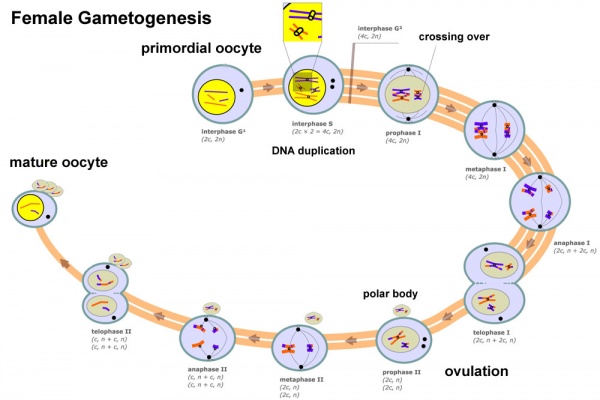Oocyte Development: Difference between revisions
From Embryology
m (moved Oocyte to Oocyte Development) |
No edit summary |
||
| Line 1: | Line 1: | ||
==Introduction== | ==Introduction== | ||
--[[User:S8600021|Mark Hill]] 10:32, 13 May 2010 (EST) Page template only. Content being prepared. | |||
[[File:Human-oocyte.jpg]] [[File:Human_oocyte-metaphase_I.jpg]] [[File:Human_oocyte-metaphase_II.jpg]] | [[File:Human-oocyte.jpg]] [[File:Human_oocyte-metaphase_I.jpg]] [[File:Human_oocyte-metaphase_II.jpg]] | ||
| Line 8: | Line 10: | ||
'''Links:''' [[2009_Lecture_2|2009 Lecture - Fertilization]] | [[2009_Lecture_3|2009 Lecture - Week 1 and 2]] | [[2009 Lecture 16|2009 Lecture - Genital Development]] | [[Zona pellucida]] | [[Spermatozoa]] | [http://embryology.med.unsw.edu.au/Notes/genital.htm original Genital Notes] | [http://embryology.med.unsw.edu.au/Notes/urogen.htm original Urogenital Notes] | '''Links:''' [[2009_Lecture_2|2009 Lecture - Fertilization]] | [[2009_Lecture_3|2009 Lecture - Week 1 and 2]] | [[2009 Lecture 16|2009 Lecture - Genital Development]] | [[Zona pellucida]] | [[Spermatozoa]] | [http://embryology.med.unsw.edu.au/Notes/genital.htm original Genital Notes] | [http://embryology.med.unsw.edu.au/Notes/urogen.htm original Urogenital Notes] | ||
== Female Gametogenesis == | |||
In females, the total number of eggs ever to be produced are present in the newborn female. | |||
# All eggs are arrested at an early stage of the first meiotic division as a primary oocyte (primordial follicle). Following purberty, during each menstrual cycle, pituitary gonadotrophin stimulates completion of '''meiosis 1''' the day before ovulation. | |||
# In '''meiosis 1''', a diploid cell becomes 2 haploid (23 chromosomes) daughter cells, each chromosome has two chromatids. One cell becomes the secondary oocyte the other cell forms the first polar body. | |||
# The secondary oocyte then commences '''meiosis 2''' which arrests at metaphase and will not continue without fertilization. | |||
# At fertilization '''meiosis 2''' completes, forming a second polar body. Note that the first polar body may also undergo this process forming a third polar body. | |||
[[File:Female_gametogenesis.jpg|600px|Female gametogenesis]] | |||
===Female Abnormalities=== | |||
[[File:Trisomy21female.jpg|thumb|Trisomy 21 female karyotype]] | |||
Meiotic non-disjunction resulting in aneuploidy, most are embryonic lethal and not seen. The potential for genetic abnormalities increase with maternal age. | |||
* Autosomal chromosome aneuploidy | |||
** trisomy 21 - [[trisomy 21|Down syndrome]] | |||
** trisomy 18 - Edwards syndrome | |||
** trisomy 13 - Patau syndrome | |||
* Sex chromosome aneuploidy | |||
** monosomy X - Turner's Syndrome | |||
** trisomy X - Triple-X syndrome | |||
** 47 XXY - Klinefelter's Syndrome | |||
==References== | ==References== | ||
Revision as of 10:32, 13 May 2010
Introduction
--Mark Hill 10:32, 13 May 2010 (EST) Page template only. Content being prepared.
Links: 2009 Lecture - Fertilization | 2009 Lecture - Week 1 and 2 | 2009 Lecture - Genital Development | Zona pellucida | Spermatozoa | original Genital Notes | original Urogenital Notes
Female Gametogenesis
In females, the total number of eggs ever to be produced are present in the newborn female.
- All eggs are arrested at an early stage of the first meiotic division as a primary oocyte (primordial follicle). Following purberty, during each menstrual cycle, pituitary gonadotrophin stimulates completion of meiosis 1 the day before ovulation.
- In meiosis 1, a diploid cell becomes 2 haploid (23 chromosomes) daughter cells, each chromosome has two chromatids. One cell becomes the secondary oocyte the other cell forms the first polar body.
- The secondary oocyte then commences meiosis 2 which arrests at metaphase and will not continue without fertilization.
- At fertilization meiosis 2 completes, forming a second polar body. Note that the first polar body may also undergo this process forming a third polar body.
Female Abnormalities
Meiotic non-disjunction resulting in aneuploidy, most are embryonic lethal and not seen. The potential for genetic abnormalities increase with maternal age.
- Autosomal chromosome aneuploidy
- trisomy 21 - Down syndrome
- trisomy 18 - Edwards syndrome
- trisomy 13 - Patau syndrome
- Sex chromosome aneuploidy
- monosomy X - Turner's Syndrome
- trisomy X - Triple-X syndrome
- 47 XXY - Klinefelter's Syndrome
References
Search
- NCBI Bookshelf oocyte | oogenesis | oocyte development
- Pubmed oocyte | oogenesis | oocyte development
Glossary Links
- Glossary: A | B | C | D | E | F | G | H | I | J | K | L | M | N | O | P | Q | R | S | T | U | V | W | X | Y | Z | Numbers | Symbols | Term Link
Cite this page: Hill, M.A. (2024, April 16) Embryology Oocyte Development. Retrieved from https://embryology.med.unsw.edu.au/embryology/index.php/Oocyte_Development
- © Dr Mark Hill 2024, UNSW Embryology ISBN: 978 0 7334 2609 4 - UNSW CRICOS Provider Code No. 00098G





